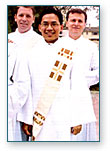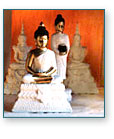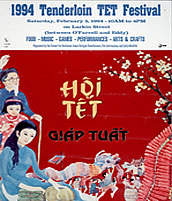Continued from page 1
 Missionaries from Spain, France, and Portugal introduced Catholicism to Vietnam in the sixteenth century. Since Catholicism was a “foreign” religion, it was seen as a threat to the established structure of the society. Catholics were therefore persecuted throughout modern Vietnamese history and were used as a political wedge to garner political support. An estimated ten percent of the Vietnamese population was Catholic, a disproportionate number of them in the North, until they were forced to migrate to the south when the country was divided in 1954. It is estimated that Catholics make up more than half the refugees who came to the United States, since they feared religious persecution by the communist regime. Cao Dai and Hoa Hao are indigenous religious sects started in the rural sectors of the Southern Delta Region in Vietnam that also have followers in the U.S. Missionaries from Spain, France, and Portugal introduced Catholicism to Vietnam in the sixteenth century. Since Catholicism was a “foreign” religion, it was seen as a threat to the established structure of the society. Catholics were therefore persecuted throughout modern Vietnamese history and were used as a political wedge to garner political support. An estimated ten percent of the Vietnamese population was Catholic, a disproportionate number of them in the North, until they were forced to migrate to the south when the country was divided in 1954. It is estimated that Catholics make up more than half the refugees who came to the United States, since they feared religious persecution by the communist regime. Cao Dai and Hoa Hao are indigenous religious sects started in the rural sectors of the Southern Delta Region in Vietnam that also have followers in the U.S.
 Cambodia and Laos share Theravada Buddhism as their national religion. In Cambodia, about 85 % of the population is Buddhist, which is the official religion of the country, embedded into national law and everyday codes of behavior. Similar to other countries in the region, with the encroachment of European powers in the 18 th and 19 th century Buddhism was often seen as a challenge to foreign control and therefore was regularly persecuted.
Cambodia and Laos share Theravada Buddhism as their national religion. In Cambodia, about 85 % of the population is Buddhist, which is the official religion of the country, embedded into national law and everyday codes of behavior. Similar to other countries in the region, with the encroachment of European powers in the 18 th and 19 th century Buddhism was often seen as a challenge to foreign control and therefore was regularly persecuted.
Because Cambodia and Laos were primarily agrarian countries, religious practices were woven into the fabric of daily life. People did not distinguish between religious practices and traditional cultural practices. They also incorporated other indigenous religions and Asian philosophies, including Taoism and Confucianism, into their national religions.
|


 Missionaries from Spain, France, and Portugal introduced Catholicism to Vietnam in the sixteenth century. Since Catholicism was a “foreign” religion, it was seen as a threat to the established structure of the society. Catholics were therefore persecuted throughout modern Vietnamese history and were used as a political wedge to garner political support. An estimated ten percent of the Vietnamese population was Catholic, a disproportionate number of them in the North, until they were forced to migrate to the south when the country was divided in 1954. It is estimated that Catholics make up more than half the refugees who came to the United States, since they feared religious persecution by the communist regime. Cao Dai and Hoa Hao are indigenous religious sects started in the rural sectors of the Southern Delta Region in Vietnam that also have followers in the U.S.
Missionaries from Spain, France, and Portugal introduced Catholicism to Vietnam in the sixteenth century. Since Catholicism was a “foreign” religion, it was seen as a threat to the established structure of the society. Catholics were therefore persecuted throughout modern Vietnamese history and were used as a political wedge to garner political support. An estimated ten percent of the Vietnamese population was Catholic, a disproportionate number of them in the North, until they were forced to migrate to the south when the country was divided in 1954. It is estimated that Catholics make up more than half the refugees who came to the United States, since they feared religious persecution by the communist regime. Cao Dai and Hoa Hao are indigenous religious sects started in the rural sectors of the Southern Delta Region in Vietnam that also have followers in the U.S. Cambodia and Laos share Theravada Buddhism as their national religion. In Cambodia, about 85 % of the population is Buddhist, which is the official religion of the country, embedded into national law and everyday codes of behavior. Similar to other countries in the region, with the encroachment of European powers in the 18 th and 19 th century Buddhism was often seen as a challenge to foreign control and therefore was regularly persecuted.
Cambodia and Laos share Theravada Buddhism as their national religion. In Cambodia, about 85 % of the population is Buddhist, which is the official religion of the country, embedded into national law and everyday codes of behavior. Similar to other countries in the region, with the encroachment of European powers in the 18 th and 19 th century Buddhism was often seen as a challenge to foreign control and therefore was regularly persecuted.